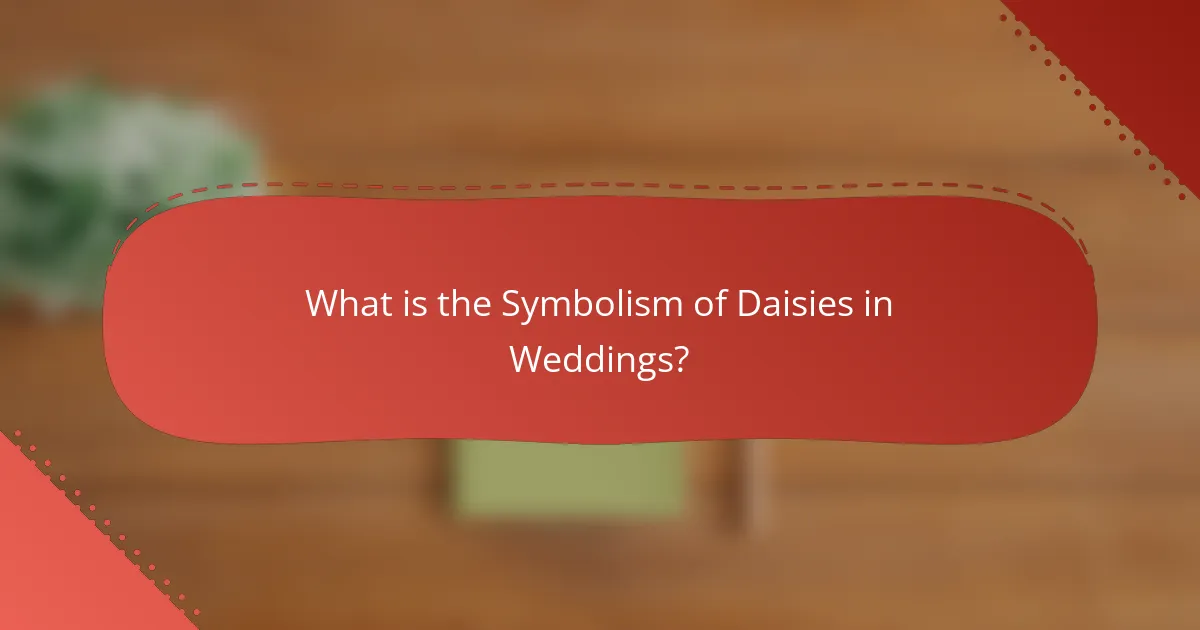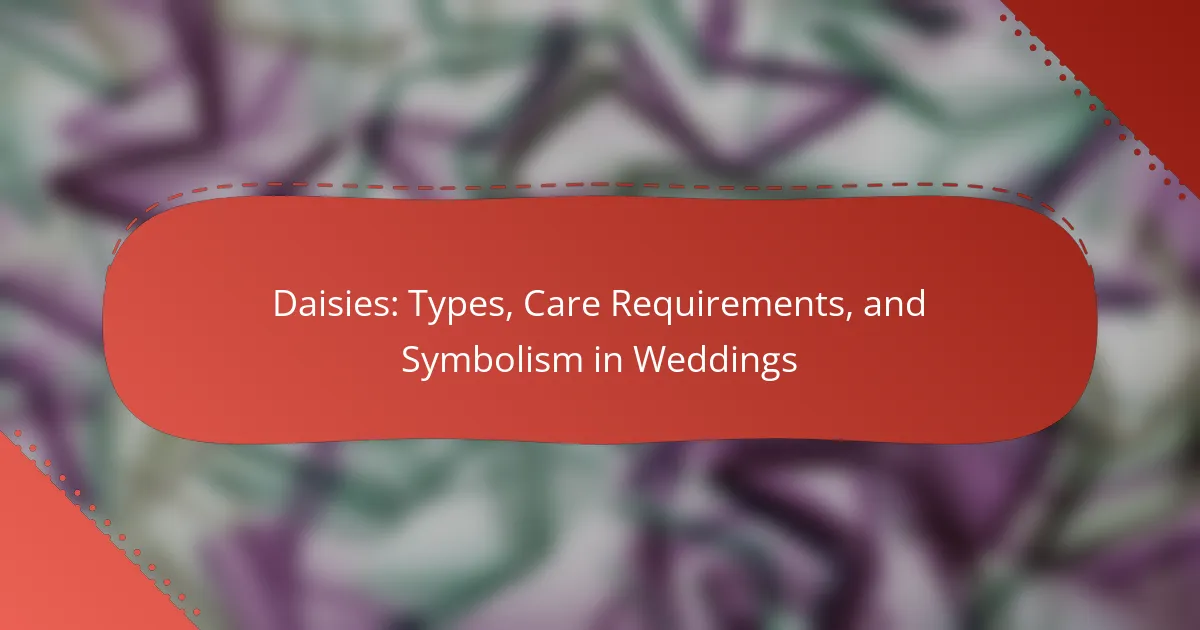
What are Daisies and Why are They Popular?
Daisies are flowering plants belonging to the Asteraceae family. They are characterized by their white petals and yellow centers. Daisies are popular due to their simplicity and beauty. They symbolize purity and innocence in various cultures. Daisies are commonly used in gardens and floral arrangements. Their resilience makes them easy to grow in diverse climates. Additionally, they attract pollinators like bees and butterflies. This ecological benefit enhances their appeal among gardeners.
How do Daisies differ from other flowers?
Daisies differ from other flowers primarily due to their unique flower structure and growth habits. They belong to the Asteraceae family, characterized by a composite flower head. This flower head consists of numerous small florets that create the appearance of a single bloom. Unlike many other flowers, daisies often have a distinct central disc surrounded by petal-like ray florets.
Daisies typically have a simple, unbranched stem and can grow in a variety of environments. They are known for their resilience and ability to thrive in poor soil conditions. Many species of daisies are perennial, meaning they return year after year, unlike some other flowers that are annual.
In terms of symbolism, daisies often represent purity and innocence, setting them apart from flowers with more complex meanings. Their straightforward beauty and ease of care make them popular in gardens and floral arrangements.
What are the key characteristics of Daisies?
Daisies are flowering plants characterized by their bright, composite flower heads. They typically feature a central disc surrounded by petal-like rays. The most common daisy, the Bellis perennis, has white petals and a yellow center. Daisies usually bloom from spring to fall, depending on the species. They thrive in well-drained soil and full sun exposure. Daisies are known for their resilience and adaptability to various climates. Many species attract pollinators like bees and butterflies. Some daisies are also used in traditional medicine for their anti-inflammatory properties.
What are the various colors and forms of Daisies?
Daisies come in various colors and forms. Common colors include white, yellow, pink, and purple. The classic daisy has white petals and a yellow center. Other forms include the Shasta daisy, which is large and white, and the Gerbera daisy, known for its vibrant hues. Daisies can also be found in a variety of sizes, from small wildflowers to larger cultivated varieties. These flowers exhibit a range of petal shapes and arrangements, contributing to their diverse appearances.
What types of Daisies are commonly found?
Common types of daisies include the Shasta daisy, Oxeye daisy, and Gerbera daisy. Shasta daisies are known for their bright white petals and yellow centers. They are popular in gardens and landscapes. Oxeye daisies are characterized by their white petals and are often found in meadows. Gerbera daisies come in various colors and are commonly used in floral arrangements. These types of daisies thrive in different environments and are widely cultivated.
What are the most popular Daisy species?
The most popular Daisy species include the Shasta Daisy, Oxeye Daisy, and Gerbera Daisy. The Shasta Daisy (Leucanthemum × superbum) is widely cultivated for its large white flowers. The Oxeye Daisy (Leucanthemum vulgare) is a common wildflower known for its resilience. The Gerbera Daisy (Gerbera jamesonii) is favored for its vibrant colors and long-lasting blooms. These species are frequently used in gardens and floral arrangements due to their aesthetic appeal and ease of care.
How do different types of Daisies vary in appearance and care?
Different types of Daisies vary significantly in appearance and care. Common Daisy types include Shasta, Oxeye, and Gerbera. Shasta Daisies have white petals and a yellow center. They thrive in full sun and well-drained soil. Oxeye Daisies feature larger blooms and can tolerate poor soil. They prefer sunny locations and can spread easily. Gerbera Daisies come in vibrant colors and have a unique shape. They require regular watering and partial shade. Care requirements also differ; Shasta Daisies need deadheading for prolonged blooming. Oxeye Daisies are low-maintenance. Gerbera Daisies benefit from fertilization every few weeks. Each type’s specific needs reflect their unique attributes and growing conditions.

What are the Care Requirements for Daisies?
Daisies require well-drained soil, full sunlight, and moderate watering. They thrive in nutrient-rich soil with a pH between 6.0 and 7.0. Regular deadheading promotes blooming and prevents seed formation. Daisies benefit from fertilization during the growing season. They should be watered deeply but infrequently to avoid root rot. Pests like aphids and slugs may need management. Additionally, dividing daisies every few years helps maintain plant vigor. These care requirements ensure healthy growth and abundant flowers.
How can you successfully grow Daisies?
To successfully grow Daisies, provide them with well-draining soil and full sunlight. Daisies thrive in a sunny environment, requiring at least six hours of direct light daily. Water them regularly, ensuring the soil remains moist but not soggy. Fertilize with a balanced, slow-release fertilizer in early spring to promote growth. Deadhead spent blooms to encourage more flowers and prevent self-seeding. Daisies prefer a pH of 6.0 to 7.0, so test the soil if growth is poor. They are hardy and can tolerate drought once established, making them low-maintenance. Following these guidelines can lead to vibrant and healthy Daisies in your garden.
What are the ideal growing conditions for Daisies?
Daisies thrive in well-drained soil with a pH between 6.0 and 7.0. They require full sun exposure for optimal growth, ideally receiving at least six hours of sunlight daily. Daisies prefer moderate watering, needing about an inch of water per week. They grow best in temperate climates, with temperatures ranging from 60°F to 75°F. These flowers benefit from regular deadheading to promote new blooms. Daisies are resilient and can tolerate drought once established. They also prefer to be spaced adequately to allow for air circulation, reducing the risk of disease.
How often should Daisies be watered and fertilized?
Daisies should be watered once a week. This frequency ensures the soil remains moist but not waterlogged. During hot weather, they may require more frequent watering. Fertilization should occur every four to six weeks during the growing season. A balanced fertilizer is recommended for optimal growth. Proper watering and fertilization promote healthy blooms and robust plants.
What common pests and diseases affect Daisies?
Daisies are affected by several common pests and diseases. Aphids are a frequent pest that can weaken the plants. They feed on the sap and can transmit viruses. Another pest is the spider mite, which causes stippling on leaves. Fungal diseases like powdery mildew can also affect daisies, leading to white, powdery spots on leaves. Additionally, root rot can occur due to overwatering or poor drainage. These conditions can lead to wilting and plant decline. Regular monitoring and proper care can help manage these issues effectively.
How can you identify and treat common Daisy pests?
Common Daisy pests include aphids, spider mites, and slugs. To identify aphids, look for small, green or black insects clustered on new growth. Spider mites create fine webbing on the undersides of leaves. Slugs leave irregular holes in leaves and produce slimy trails.
To treat aphids, spray them with a strong stream of water or use insecticidal soap. For spider mites, increase humidity and apply miticides if necessary. Slugs can be controlled by handpicking or using bait traps. Regular monitoring helps prevent infestations.
What diseases should you be aware of when caring for Daisies?
Daisies can be affected by several diseases. Key diseases include powdery mildew, which causes white fungal growth on leaves. Another common issue is root rot, often caused by overwatering. Leaf spot is also a concern, leading to dark spots on foliage. Additionally, aphids can transmit viral diseases that stunt growth. Regular monitoring and proper care can help prevent these issues.

What is the Symbolism of Daisies in Weddings?
Daisies symbolize purity, innocence, and new beginnings in weddings. Their simple beauty conveys a sense of freshness and joy. Daisies are often associated with love and fidelity. This is due to their unpretentious nature and vibrant appearance. Historically, they have been used in bridal bouquets and floral arrangements. The white petals represent purity, while the yellow center signifies happiness. Daisies also embody the idea of true love, making them a popular choice for wedding themes. Their symbolism aligns with the values of commitment and harmony in marriage.
Why are Daisies chosen for wedding decorations?
Daisies are chosen for wedding decorations because they symbolize purity and innocence. Their simple yet elegant appearance complements various wedding themes. Daisies are also versatile and can be arranged in bouquets, centerpieces, or as accents. They are available in multiple colors, enhancing their appeal. Additionally, daisies are relatively affordable compared to other flowers. Their long-lasting nature ensures they remain fresh throughout the event. Daisies are often associated with love and new beginnings, making them a fitting choice for weddings.
What do Daisies symbolize in the context of love and marriage?
Daisies symbolize innocence and purity in the context of love and marriage. Their simple beauty represents true love and loyalty. Daisies are often associated with new beginnings, making them popular in wedding arrangements. The flower’s white petals signify purity, while the yellow center symbolizes happiness. Historically, daisies have been used in romantic contexts for centuries. They are frequently included in bridal bouquets and decorations to convey heartfelt emotions. In folklore, daisies are believed to bring joy and hope to relationships. Their symbolism enhances the romantic atmosphere of weddings.
How can Daisies enhance the overall wedding theme?
Daisies can enhance the overall wedding theme by adding a touch of simplicity and elegance. Their bright and cheerful appearance complements various color palettes. Daisies symbolize purity and innocence, making them ideal for weddings. They can be used in bouquets, centerpieces, and floral arrangements. Incorporating daisies can create a whimsical and romantic atmosphere. Their versatility allows for both rustic and modern themes. Daisies are also cost-effective, fitting various budget ranges. Overall, they contribute to a joyful and fresh ambiance at weddings.
What are some popular ways to incorporate Daisies into weddings?
Daisies can be incorporated into weddings in various popular ways. One common method is using them in bridal bouquets. Daisies add a cheerful and fresh look to floral arrangements. They can also be used as centerpieces for tables. Arranging daisies in mason jars creates a rustic charm. Another option is to use daisies in boutonnieres for groomsmen. This adds a cohesive floral theme to the wedding party. Daisies can also be included in floral crowns for brides and flower girls. This enhances the whimsical feel of the wedding. Additionally, daisies can be used in wedding decorations, such as aisle markers or cake toppers. Their versatility makes them a popular choice for many wedding styles.
How can Daisies be used in bridal bouquets and centerpieces?
Daisies can be used in bridal bouquets and centerpieces as vibrant and cheerful floral elements. Their simple, yet elegant appearance complements various wedding themes. Daisies are available in multiple colors, enhancing visual appeal. They can be combined with other flowers for a fuller bouquet. Their sturdy stems make them suitable for arrangements. Daisies symbolize innocence and purity, adding sentimental value to weddings. They are also cost-effective, making them accessible for budget-conscious couples. Using daisies can create a fresh and natural look in both bouquets and centerpieces.
What are creative ideas for using Daisies in wedding favors?
Daisies can be creatively used in wedding favors in various ways. One idea is to create small bouquets of fresh daisies tied with twine. This option provides guests with a charming keepsake. Another idea is to use dried daisies in homemade potpourri. This adds a fragrant touch to the favor. Additionally, daisies can be incorporated into seed packets. Guests can plant them at home, symbolizing growth and new beginnings. Customized jars of honey infused with daisy petals also make for unique favors. These options highlight the flower’s beauty and significance. Each idea reflects the joyful spirit of weddings and the symbolism of daisies.
What tips can ensure the best use of Daisies in weddings?
Daisies can enhance weddings beautifully when used thoughtfully. Select fresh daisies for arrangements to ensure vibrant colors and longevity. Consider using them in bouquets, centerpieces, and boutonnieres for a cohesive look. Pair daisies with complementary flowers like roses or peonies for added texture. Choose a color palette that aligns with the wedding theme to create harmony. Utilize various daisy types, such as Shasta or Gerbera, to add visual interest. Incorporate daisies into wedding favors or decorations for a personal touch. Lastly, ensure proper care by keeping them hydrated before the event to maintain freshness.
How can you select the freshest Daisies for your wedding?
Select the freshest Daisies for your wedding by checking for vibrant color and firm petals. Fresh Daisies should have bright white petals and a rich yellow center. Inspect the stems; they should be green and sturdy, not wilted or brown. Smell the flowers; fresh Daisies should have a pleasant, light fragrance. Avoid any flowers with browning leaves or damaged petals. Purchase from reputable florists or growers who prioritize freshness. Research shows that flowers sourced directly from farms have a longer vase life.
What are some common mistakes to avoid when using Daisies in weddings?
Common mistakes to avoid when using daisies in weddings include selecting the wrong variety. Some daisy types may wilt quickly in warm conditions. Failing to consider color coordination can clash with the wedding theme. Overlooking the size of daisies can lead to disproportionate arrangements. Neglecting to check for allergies can affect guests. Using daisies without proper care can result in drooping or browning. Finally, not incorporating them into the overall floral design can make arrangements appear disjointed.
Daisies are flowering plants from the Asteraceae family, known for their white petals and yellow centers, symbolizing purity and innocence. This article covers the various types of daisies, including Shasta, Oxeye, and Gerbera, along with their specific care requirements such as soil, sunlight, and watering needs. It also explores common pests and diseases affecting daisies, as well as their significance in weddings, highlighting their use in floral arrangements and decorations. Additionally, the article provides tips for selecting and using daisies effectively in wedding settings.
